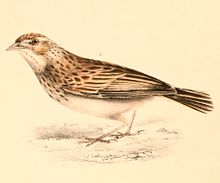Melodious lark
| Melodious lark | |
|---|---|

| |
| Scientific classification | |
| Domain: | Eukaryota |
| Kingdom: | Animalia |
| Phylum: | Chordata |
| Class: | Aves |
| Order: | Passeriformes |
| Family: | Alaudidae |
| Genus: | Mirafra |
| Species: | M. cheniana
|
| Binomial name | |
| Mirafra cheniana Smith, 1843
| |

| |
| range | |
The melodious lark (Mirafra cheniana) is a species of
Taxonomy and systematics
The alternate name of singing bush lark usually refers to the species of that name,
Distribution and habitat
The melodious lark has a probable maximum
Habitat
The natural
Melodious larks select different textures of grass or grass parts to build their domed, obliquely-accessed nests. They use the harder and more fibrous grasses and stalks for an outer thatch, while the finer and softer grasses or grass leaves are used to line the nest's interior.[3]
Behaviour and ecology
Breeding
The melodious lark is assessed as likely to be both
Food and feeding
The melodious lark forages on the ground for food, eating mostly grass seeds supplemented with insects.[3]
References
- . Retrieved 14 November 2021.
- ^ "Mirafra cheniana - Avibase". avibase.bsc-eoc.org. Retrieved 2016-12-10.
- ^ a b c d e f g Compilers: Andrew O'Brien, Joe Taylor (2008). "Melodious Lark - BirdLife Species Factsheet". Evaluators: Stuart Butchart, Joe Taylor. BirdLife International. Retrieved May 11, 2009.
External links
- Melodious lark - Species text in The Atlas of Southern African Birds.

